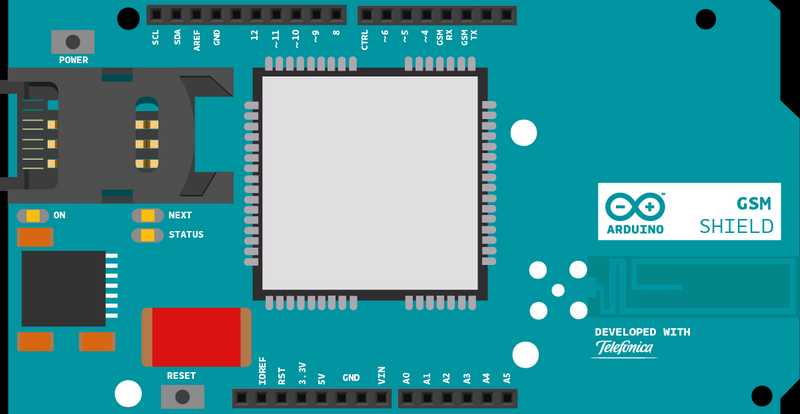Send SMS
This sketch send a SMS message from an Arduino board equipped with a GSM shield. Using the serial monitor of the Arduino Software (IDE), you'll enter the number to connect with, and the text message to send.
Hardware Required
Arduino Board
SIM card
Circuit

image of the Arduino GSM Shield on top of an Arduino board
Code
First, import the GSM library
#include <GSM.h>
SIM cards may have a PIN number that enables their functionality. Define the PIN for your SIM. If your SIM has no PIN, you can leave it blank :
#define PINNUMBER ""
Initialize instances of the classes you're going to use. You're going to need both the GSM and GSM_SMS class.
GSM gsmAccess;
GSM_SMS sms;In setup, open a serial connection to the computer. After opening the connection, send a message indicating the sketch has started.
void setup(){
Serial.begin(9600);
Serial.println("SMS Messages Sender");Create a local variable to track the connection status. You'll use this to keep the sketch from starting until the SIM is connected to the network :
boolean notConnected = true;Connect to the network by calling gsmAccess.begin(). It takes the SIM card's PIN as an argument. By placing this inside a while() loop, you can continually check the status of the connection. When the modem does connect, gsmAccess() will return GSM_READY. Use this as a flag to set the notConnected variable to true or false. Once connected, the remainder of setup will run.
while(notConnected)
{
if(gsmAccess.begin(PINNUMBER)==GSM_READY)
notConnected = false;
else
{
Serial.println("Not connected");
delay(1000);
}
}Finish setup with some information to the serial monitor.
Serial.println("GSM initialized.");
}Create a function named readSerial of type int. You'll use this to iterate through input from the serial monitor, storing the number you wish to send an SMS to, and the message you'll be sending. It should accept a char array as an argument.
int readSerial(char result[])
{Create a variable to count through the items in the serial buffer, and start a while loop that will continually execute.
int i = 0;
while(1)
{As long as there is serial information available, read the data into a variable named inChar.
while (Serial.available() > 0)
{
char inChar = Serial.read();If the character being read is a newline, terminate the array, clear the serial buffer and exit the function.
if (inChar == '\n')
{
result[i] = '\0';
Serial.flush();
return 0;
}If the incoming character is an ASCII character other than a newline or carriage return, add it to the array and increment the index. Close up the while loops and the function.
if(inChar!='\r')
{
result[i] = inChar;
i++;
}
}
}
}In loop, create a char array named remoteNumber to hold the number you wish to send an SMS to. Invoke the readSerial function you just created, and pass remoteNumber as the argument. When readSerial executes, it will populate remoteNumber with the number you wish to send the message to.
Serial.print("Enter a mobile number: ");
char remoteNumber[20];
readSerial(remoteNumber);
Serial.println(remoteNumber);Create a new char array named txtMsg. This will hold the content of your SMS. Pass txtMsg to readSerial to populate the array.
Serial.print("Now, enter SMS content: ");
char txtMsg[200];
readSerial(txtMsg);Call sms.beginSMS() and pass it remoteNumber to start sending the message, sms.print() to send the message, and sms.endSMS() to complete the process. Print out some diagnostic information and close the loop. Your message is on its way!
Serial.println("SENDING");
Serial.println();
Serial.println("Message:");
Serial.println(txtMsg);
sms.beginSMS(remoteNumber);
sms.print(txtMsg);
sms.endSMS();
Serial.println("\nCOMPLETE!\n");
}Once your code is uploaded, open the serial monitor. Make sure the serial monitor is set to only send a newline character on return. When prompted to enter the number you wish to call, enter the digits and press return. You'll then be asked to enter your message. Once you've typed that, press return again to send it.
The complete sketch is below.
See Also:
GSM Constructor
GSM_SMS Constructor
beginSMS()
ready()
endSMS()
read()
write()
print()
peek()
flush()
Arduino GSM Shield - Complete product description.
Getting started with the GSM Shield - Get everything set up in minutes.
GSM library - Your reference for the GSM Library.
GSMExamplesMakeVoiceCall - How to make a voice call with mic and speaker.
GSMExamplesReceiveVoiceCall - The call is received and connected, the number that is calling is shown on serial monitor and then the call is hung up.
GSMExamplesReceiveSMS - How to receive an SMS message.
GSMExamplesWebServer - A web server that when gets a request from a client sends back the value read on Analog inputs.
GSMExamplesWebClient - Connect to the Arduino.cc home and print the contents on the serial monitor window.
GSMToolsTestGPRS - Tries to access the internet over GPRS with supplied APN and credentials.
Last revision 2018/08/23 by SM